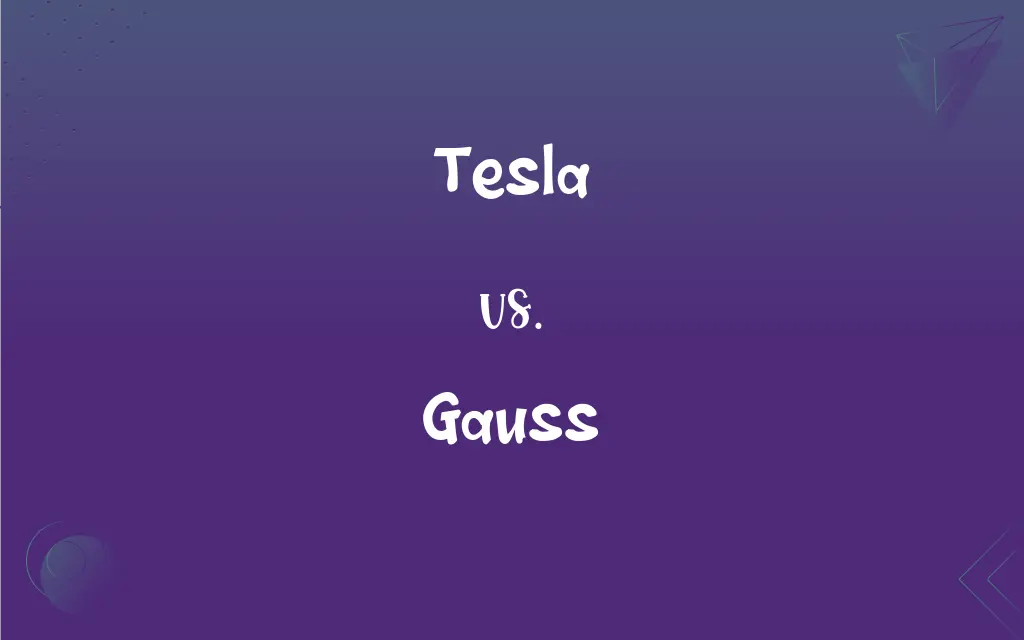Tesla vs. Gauss: What's the Difference?
Edited by Aimie Carlson || By Harlon Moss || Published on February 26, 2024
Tesla (T) and Gauss (G) are units of magnetic field strength; 1 Tesla equals 10,000 Gauss.

Key Differences
Tesla and Gauss are units of measurement in the field of electromagnetism, each serving a unique purpose in understanding magnetic fields. A Tesla (T) is a larger unit that measures the strength of magnetic fields, typically used in large-scale magnetic field measurements. On the other hand, a Gauss (G) is a smaller unit, with 1 Tesla equaling 10,000 Gauss, making Gauss suitable for weaker magnetic fields. While Tesla is used in the International System of Units (SI), Gauss is part of the centimeter-gram-second (CGS) system, highlighting their different applications and contexts. In medical imaging, for example, Tesla is commonly used in the context of MRI machines, whereas Gauss is often used in smaller applications like the magnetic fields of the Earth.
In scientific research and industrial applications, Tesla and Gauss both play crucial roles but at different scales and precision levels. When dealing with extremely strong magnetic fields, such as those in particle accelerators, Tesla is the preferred unit due to its larger magnitude. Conversely, Gauss finds its use in everyday applications, like in the fields produced by bar magnets, where the magnetic field strength is relatively low. The difference in their magnitude (1 Tesla = 10,000 Gauss) makes Tesla more suited for high-intensity fields, while Gauss is more practical for smaller, more precise measurements. This distinction reflects the adaptability of magnetic field units to various scientific and practical needs.
In terms of historical context, both Tesla and Gauss are named after eminent scientists who contributed significantly to the field of electromagnetism. The Tesla is named after Nikola Tesla, a pioneering inventor and electrical engineer whose work in alternating current (AC) power systems revolutionized electricity distribution. The Gauss, meanwhile, is named after Carl Friedrich Gauss, a German mathematician and physicist known for his contributions to a wide range of scientific disciplines, including magnetism. Their respective units, Tesla and Gauss, honor their contributions and provide a legacy that extends into modern scientific measurement. Although different in magnitude, both units reflect the enduring impact of these scientists on the understanding of magnetic phenomena.
Understanding the practical usage of Tesla and Gauss in technology and science is crucial for students and professionals alike. Tesla is predominantly used in advanced physics and engineering fields, such as in the design and operation of MRI machines, where precise and strong magnetic fields are essential. In contrast, Gauss is often encountered in education and consumer electronics, where smaller magnetic fields are more common, such as in the speakers of smartphones and headphones. Despite the difference in scale, both Tesla and Gauss are integral in measuring and applying magnetic fields across a wide spectrum of technologies, illustrating their versatility and importance in modern science and engineering.
Comparison Chart
Unit Type
SI unit
Non-SI (CGS) unit
ADVERTISEMENT
Size Comparison
Larger unit
Smaller unit
Equivalent Conversion
1 Tesla = 10,000 Gauss
1 Gauss = 0.0001 Tesla
Common Usage
Modern scientific literature
Older literature, certain fields
Suitable For
Stronger magnetic fields
Weaker magnetic fields
Tesla and Gauss Definitions
Tesla
Tesla is a unit of magnetic flux density in the International System of Units.
The MRI machine operates at a magnetic field strength of 1.5 Tesla.
ADVERTISEMENT
Gauss
Gauss, being a smaller unit, is practical for everyday magnetic field measurements.
A typical refrigerator magnet has a strength of about 50 Gauss.
Tesla
Tesla is used to quantify the strength and direction of a magnetic field.
Scientists measured the Earth's magnetic field as being less than one Tesla.
Gauss
Gauss measures magnetic flux density or magnetic induction, similar to Tesla but smaller.
Earth's magnetic field is approximately 0.5 Gauss.
Tesla
Tesla is a standard unit in electromagnetism, crucial in technologies like MRI.
The clarity of MRI images is greatly influenced by the Tesla rating of the scanner.
Gauss
Gauss is a unit of magnetic field strength in the centimeter-gram-second (CGS) system.
The magnetic field of a small bar magnet is about 100 Gauss.
Tesla
Tesla can also be used to express the intensity of magnetic shields.
The spacecraft's magnetic shield was designed to withstand fields up to 5 Teslas.
Gauss
Gauss is often used in geophysics and old scientific texts to describe magnetic properties.
Early compasses were calibrated using the Gauss unit.
Tesla
Tesla signifies the level of magnetic induction or magnetic flux per unit area.
Industrial electromagnets often generate fields measured in multiple Teslas.
Gauss
Gauss is suitable for measuring weaker magnetic fields with more precision than Tesla.
In lab experiments, scientists frequently use Gauss to measure subtle magnetic variations.
Tesla
The SI-derived unit of magnetic flux density, equal to the magnitude of the magnetic field vector necessary to produce a force of one newton on a charge of one coulomb moving perpendicular to the direction of the magnetic field vector with a velocity of one meter per second. It is equivalent to one weber per square meter. See Table at measurement.
Gauss
The centimeter-gram-second unit of magnetic flux density, equal to one maxwell per square centimeter.
Tesla
In the International System of Units, the derived unit of magnetic flux density or magnetic inductivity. Symbol: T
Gauss
The unit of magnetic field strength in CGS systems of units, equal to 0.0001 tesla.
Tesla
A unit of magnetic flux density equal to one weber per square meter
Gauss
The C.G.S. unit of density of magnetic field, equal to a field of one line of force per square centimeter, being thus adopted as an international unit at Paris in 1900; sometimes used as a unit of intensity of magnetic field. It was previously suggested as a unit of magnetomotive force.
Tesla
United States electrical engineer and inventor (born in Croatia but of Serbian descent) who discovered the principles of alternating currents and developed the first alternating-current induction motor and the Tesla coil and several forms of oscillators (1856-1943)
Gauss
Karl F. Gauss, a German mathematician.
Gauss
A unit of magnetic flux density equal to 1 maxwell per square centimeter
Gauss
German mathematician who developed the theory of numbers and who applied mathematics to electricity and magnetism and astronomy and geodesy (1777-1855)
FAQs
Can Tesla and Gauss be used interchangeably?
They measure the same phenomenon but are different in magnitude, so conversion is needed.
What is a Tesla?
Tesla is the SI unit of magnetic flux density or magnetic induction.
What does Gauss measure?
Gauss measures magnetic field strength, specifically magnetic flux density.
Why is Tesla more common in modern literature?
Tesla aligns with the International System of Units (SI), making it the standard in scientific research.
How do Tesla and Gauss compare in size?
1 Tesla is significantly larger, equivalent to 10,000 Gauss.
How do you convert Gauss to Tesla?
Multiply the Gauss value by 0.0001 to convert to Tesla.
What fields use Tesla as a unit?
Tesla is commonly used in physics, engineering, and medical imaging, like MRI.
Who is the Gauss unit named after?
It's named after Carl Friedrich Gauss, a German mathematician and physicist.
Who is the Tesla unit named after?
It's named after Nikola Tesla, a pioneer in electricity and magnetism.
Is Gauss suitable for everyday magnetic measurements?
Yes, its smaller size makes it practical for measuring weaker magnetic fields.
Is learning about Gauss important for modern physics students?
Understanding Gauss is useful for historical context and in specific applications, though Tesla is more prevalent.
Where is Gauss still used?
Gauss is used in older scientific literature and in some specific fields like geophysics.
Can the average person encounter Tesla in daily life?
Not typically, as Tesla units are used for strong magnetic fields not common in everyday environments.
What does 1 Tesla indicate in terms of magnetic field strength?
It indicates a very strong magnetic field, often seen in industrial and scientific applications.
Are there any common devices that use the Gauss unit?
Yes, compasses and small magnets are often measured in Gauss.
How does Earth's magnetic field compare in Tesla and Gauss?
Earth's magnetic field is about 0.00005 Tesla or 0.5 Gauss.
Why might someone prefer using Gauss over Tesla?
Gauss is preferred for its precision in measuring weaker magnetic fields.
Are there instruments that measure in both Tesla and Gauss?
Yes, some scientific instruments can display readings in both Tesla and Gauss.
Is Tesla relevant in medical technologies?
Absolutely, Tesla is crucial in MRI technology for determining magnetic field strength.
Is Tesla used in academic research?
Yes, Tesla is widely used in academic and scientific research for magnetic field measurements.
About Author
Written by
Harlon MossHarlon is a seasoned quality moderator and accomplished content writer for Difference Wiki. An alumnus of the prestigious University of California, he earned his degree in Computer Science. Leveraging his academic background, Harlon brings a meticulous and informed perspective to his work, ensuring content accuracy and excellence.
Edited by
Aimie CarlsonAimie Carlson, holding a master's degree in English literature, is a fervent English language enthusiast. She lends her writing talents to Difference Wiki, a prominent website that specializes in comparisons, offering readers insightful analyses that both captivate and inform.







































































